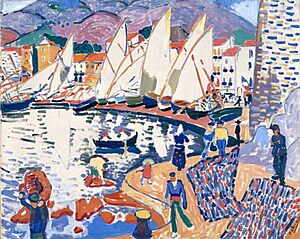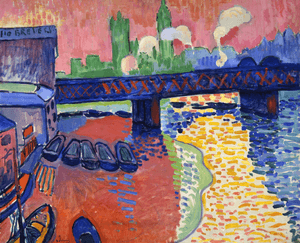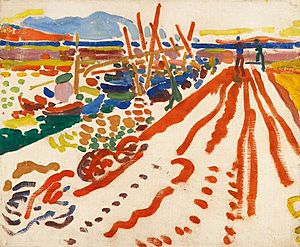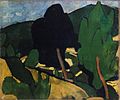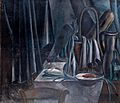André Derain facts for kids
Quick facts for kids
André Derain
|
|
|---|---|
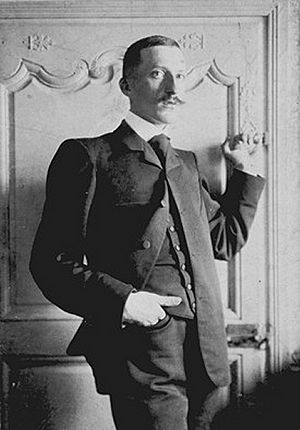
André Derain, 1903
|
|
| Born | 10 June 1880 |
| Died | 8 September 1954 (aged 74) Garches, Hauts-de-Seine, Île-de-France, France
|
| Education | Académie Camillo, Académie Julian |
| Known for | Painting, sculpture |
| Movement | Fauvism |
André Derain (born June 10, 1880 – died September 8, 1954) was a famous French artist. He was a painter and sculptor. He also helped start a new art style called Fauvism with another artist, Henri Matisse.
Contents
Biography
André Derain's Early Life
André Derain was born in 1880 in Chatou, a town near Paris, France. He started learning to paint by himself in 1895. He sometimes went to the countryside with an old friend of Paul Cézanne's.
In 1898, he was studying to become an engineer. But he also took painting classes. There, he met the artist Henri Matisse. In 1900, he met Maurice de Vlaminck and they shared a studio. They painted scenes from their neighborhood together. This was put on hold when Derain had to join the military from 1901 to 1904.
After his military service, Matisse convinced Derain's parents. They agreed to let him stop engineering and focus only on painting. Derain then went to a famous art school called the Académie Julian.
The Fauvism Art Movement
In the summer of 1905, Derain and Matisse worked together. They painted in a village by the Mediterranean Sea called Collioure. Later that year, they showed their new paintings at an art show in Paris. The paintings used very bright, unusual colors.
An art critic saw their work and called them les Fauves. This means "the wild beasts" in French. This name stuck, and it marked the beginning of the Fauvist art movement.
In 1906, a well-known art dealer named Ambroise Vollard sent Derain to London. Derain was asked to paint a series of pictures of the city. He created 30 paintings of London. These were very different from what other artists had painted before.
Derain used bold colors and strong designs. He painted many scenes of the River Thames and Tower Bridge. These London paintings are still some of his most famous works today.
In 1907, another art dealer bought all the paintings in Derain's studio. This gave Derain money and stability. He also tried making sculptures out of stone. He moved to Montmartre to be closer to his friend Pablo Picasso and other artists.
Picasso's girlfriend at the time, Fernande Olivier, described Derain. She said he was "Slim, elegant, with a lively color and enameled black hair. With an English chic, somewhat striking. Fancy waistcoats, ties in crude colors, red and green. Always a pipe in his mouth, phlegmatic, mocking, cold, an arguer."
In Montmartre, Derain started to change his painting style. He moved away from the bright Fauvist colors. He began using more muted, softer tones. This showed the influence of Cubism and Paul Cézanne. He also created woodcut illustrations for a book by Guillaume Apollinaire in 1909. His art was shown in important exhibitions in Munich, New York, and other cities.
A New Classic Style
Around this time, Derain's art started to look like older, traditional paintings. He studied the works of the Old Masters. He used less color, and his shapes became simpler and stronger. The years from 1911 to 1914 are sometimes called his "gothic period."
In 1914, he joined the military for World War I. He had little time to paint until he was released in 1919. However, he did create illustrations for a book in 1916.
After the war, Derain became famous again. He was seen as a leader in a new style that looked back to classic art. He was admired for keeping traditions alive. In 1919, he designed the sets and costumes for a ballet called La Boutique fantasque. It was a big success. This led him to design many more ballets.
The 1920s were a very successful time for Derain. He won an important art award in 1928. His paintings were shown in many cities around the world. These included London, Berlin, and New York City.
During World War II, Germany occupied France. Derain lived in Paris and was seen as an important French artist. He accepted an invitation to visit Germany in 1941. He traveled with other French artists to see an art exhibition. This visit caused problems for his reputation after the war.
A year before he died, Derain got an eye infection. He never fully recovered from it. He passed away in 1954 in Garches, France. He was hit by a moving vehicle.
Derain's London paintings were featured in a special exhibition. It took place at the Courtauld Institute from late 2005 to early 2006.
Works
Public collections
Some museums and art galleries that have works by André Derain include:
- Museum of Fine Arts, Ghent, Gent, Belgium
- Museum de Fundatie, Zwolle, Netherlands
See also
 In Spanish: André Derain para niños
In Spanish: André Derain para niños


